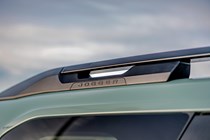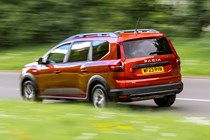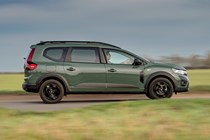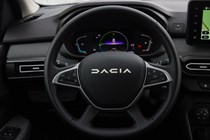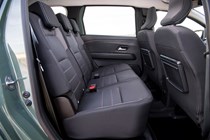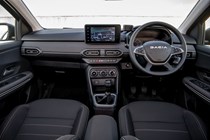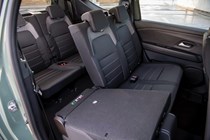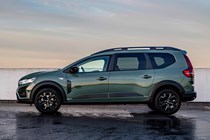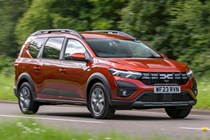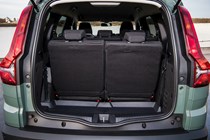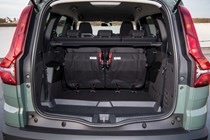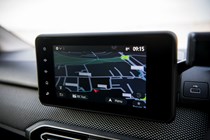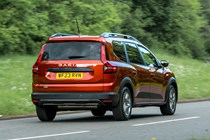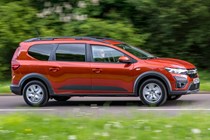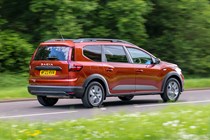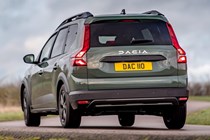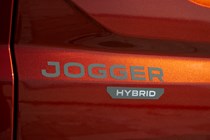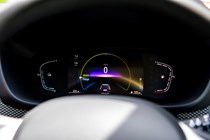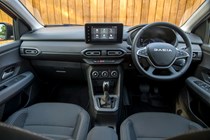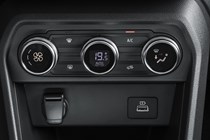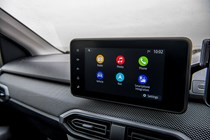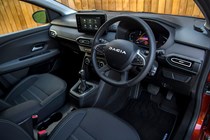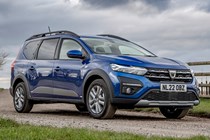Dacia Jogger engines, drive and performance
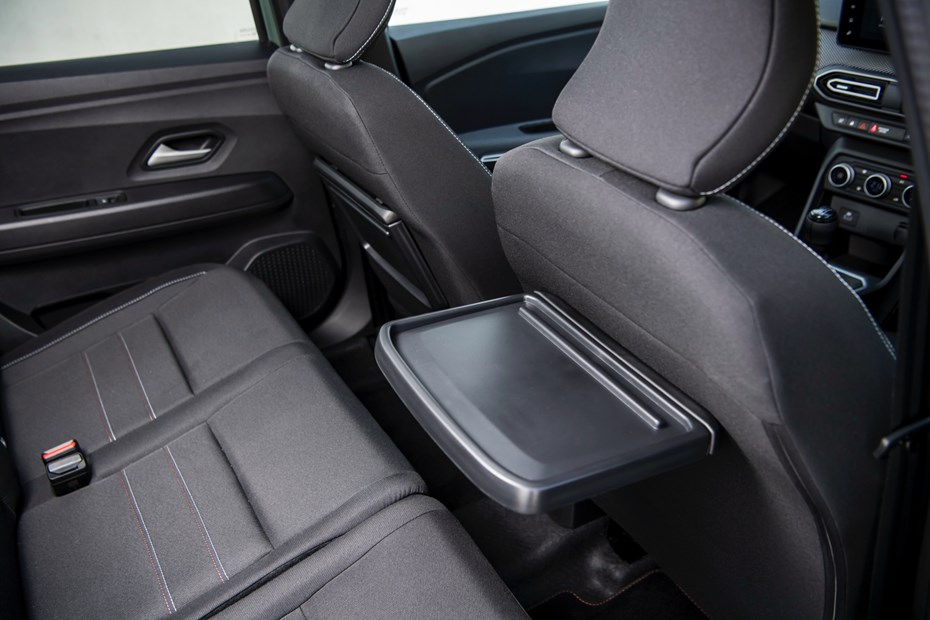
- Petrol engine offers adequate performance
- Hybrid option is noisy but punchy
- Surprisingly involving to drive
Petrol engine
The Dacia Jogger’s lone petrol engine is a 1.0-litre, three-cylinder turbocharged unit – badged TCe 110. It produces 110hp and 200Nm of torque – not particularly impressive numbers, but perfectly adequate for the car’s light 1,200kg-ish weight. Fully laden, though, the engine can struggle to haul everything along. Regardless, most owners should be more than satisfied with its blend of performance and economy.
Paired with a six-speed manual transmission, the engine does need working hard to make quick progress. You can take it a little easier without holding anybody up, though, and the Jogger cruises in a relaxed fashion. Drivers new to the Jogger might find the surging power delivery as the turbo kicks in can make it difficult to drive smoothly. But, once in that power sweet spot, it’s surprisingly quick.

Just expect to stir the notchy six-speed manual gearbox quite a lot, especially if you’re fully laden or driving up and down hills. We found the tall sixth gear is good enough for gentle motorway cruising. But introduce it to inclines, especially when loaded, and fifth and sometimes even fourth gear were needed to maintain momentum.
Hybrid engine
The 1.6-litre petrol self-charging hybrid available in the Jogger – badged Hybrid 140 – is more economical and more powerful, and it comes with an automatic gearbox. With 140hp, the 0–62mph time improves by around a second. It uses a unique type of six-speed automatic gearbox specific to Dacia and Renault models: an electric motor takes the place of a clutch and a second motor fills in the resulting gaps in power delivery.
The result is that, under hard acceleration, the Jogger feels distinctly lumpy compared to rivals with seven- or eight-speed torque convertor or dual-clutch automatic gearboxes. It shares some characteristics with CVT-equipped hybrids, specifically a willingness to let the revs spiral if you put your foot down.
Dacia reckons the Jogger can run around at city speeds in electric mode for around 80% of the time. We reckon it was a bit less than that in our testing, but it does spend a lot of time using just the electric motors. And that’s a good thing – when it’s in pure EV mode it’s smooth and pretty quiet.
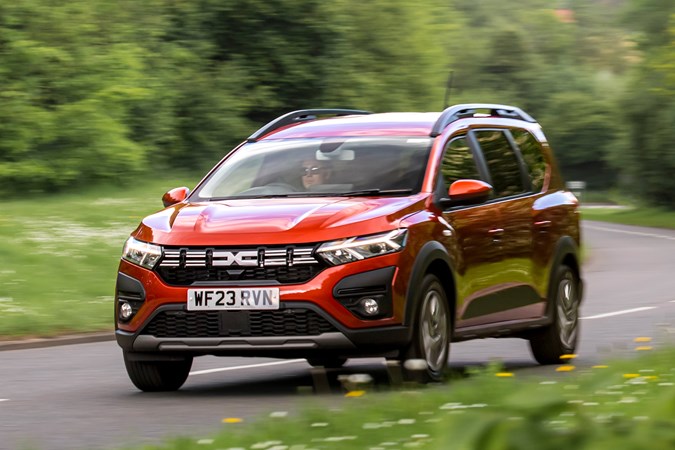
The problem comes when the petrol engine kicks into life. It’s loud and the transition isn’t particularly smooth – you can really hear and feel it kick in. Under harsh acceleration the revs rise at a rate not in line with actual acceleration, which is annoying.
However, driven gently you soon learn to live with its foibles and, while the soundtrack isn’t ever particularly pleasant, it’s easily drowned out by the stereo. It’s rarely louder than a diesel engine would be. The hybrid is punchy enough to deal with even a fully loaded Jogger, and it’s very efficient too.
What’s it like to drive?
- Feels lights and easy
- Soft ride is very comfortable
- Can be rather amusing on a country road
The Jogger’s 200mm of ground clearance, small wheels and soft suspension allow it to effortlessly soak up most bumps and potholes. The payoff is that it can feel a bit wallowy on some roads, especially undulating A-roads, and that the body leans over markedly in corners. Importantly, though, it’s perfectly comfortable in most situations, for passengers in all three rows of seats.
It won’t come as any surprise that the Jogger doesn’t exactly feel like a hot hatchback in corners. The steering is light and precise, but you don’t really feel connected to it, and it tells you little about what’s going on under the front tyres. The Jogger is at its best at a fairly relaxed pace, but we were impressed by how much speed we could carry through corners. If you’re inclined to get a shift on driving along a country road, the Jogger can be surprisingly fun. All of which is equally true of Jogger rivals such as the Renault Kangoo and Volkswagen Caddy.
The brakes on hybrid models can be a bit tricky to use. The car uses regenerative braking, capturing kinetic energy that would otherwise be lost as heat. The energy is turned into electricity, used to power the motors. All good for mpg. But when you brake, the transition between regen and the wheel brakes can be jerky. And there can be a lot of travel in the pedal before much braking happens.
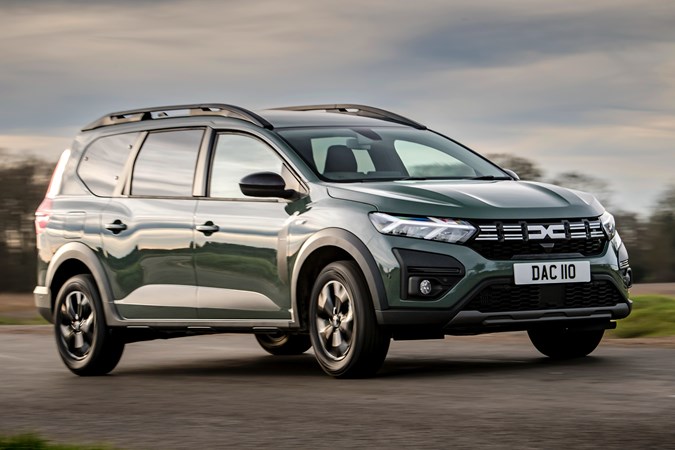
It’s also rather a shame that the Jogger isn’t available with four-wheel drive – an option on some rivals. But a set of suitable tyres should see you through most ‘soft-roading’ exploits – rough tacks, muddy fields and so on. In winter, we suspect it’s near unstoppable on all-weather or winter tyres.
Dacia has also recognised that its owners might want to venture off the beaten track in a Jogger, including its Extended Grip system on the range-topping Extreme model. It’s a piece of software that adjusts the car’s electronic stability control settings to keep the wheels turning and the car moving on loose surfaces. We’ll report on its effectiveness once we’ve tried it.



